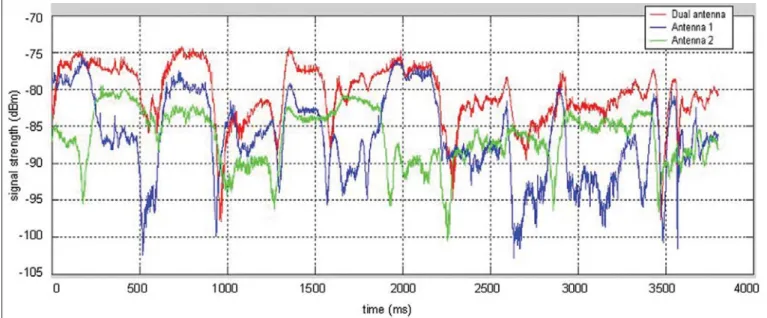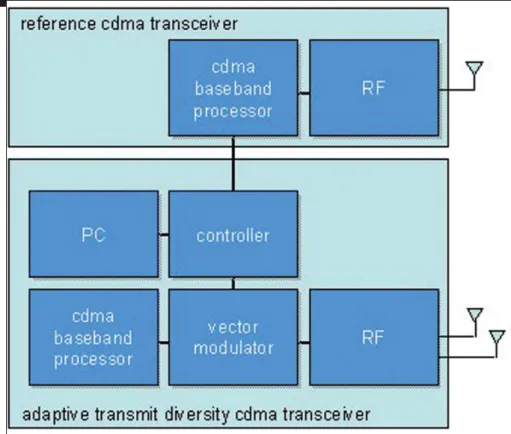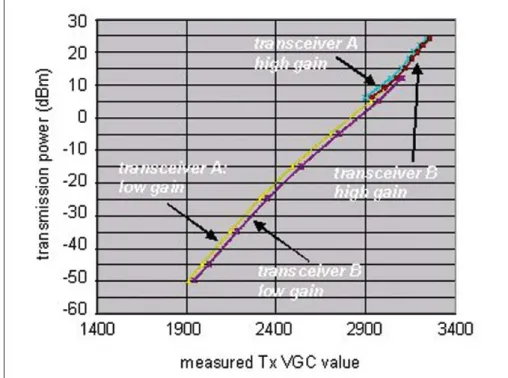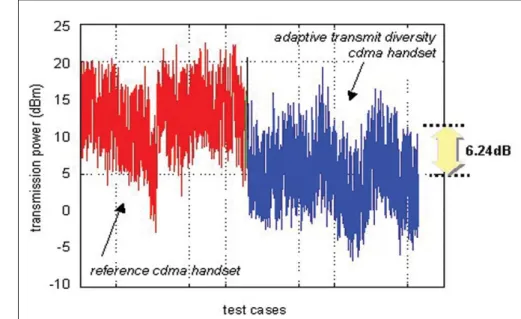50 www.rfdesign.com October 2003
A
s the demand for wireless voice and data services has grown, there has been an increased usage of wireless data services, such as wireless e-mail, Web browsing and instant messaging — with many services now incorporating high data rate multimedia capa-bilities for simultaneous voice, image, and real-time video transfer.Such services will inevitably lead to a shift from the present asymmetrical uplink and downlink traffic load to a more evenly bal-anced load. As traffic demand continues to outstrip the supply of network capacity, the cellular operators must continuously seek alternative means for enhancing system capacity, throughput, coverage, and range to maintain an acceptable quality of service and to remain competitive in the marketplace.
A wide range of solutions has historically been employed to meet these performance challenges. These solutions typically fall into four broad categories - regulatory, network design, standards, and radio technology.
Regulatory solutions involve the introduc-tion of new or shared RF spectrum, allocated to specific operators or designated for specific types of services. Unfortunately, these solu-tions are limited by the available spectrum resources and often require many years to implement.
Network design involves modifications to a carrier’s wireless network infrastructure and RF planning, and is perhaps the most common approach employed for enhancing system per-formance. Operators continuously seek to optimize their RF utilization by regularly deploying new basestation sites, adding addi-tional sectors to existing sites, and by adjust-ing their RF frequency plans to reduce
inter-ference, increase capacity and improve cover-age. While these solutions are very effective, they can be quite costly and time-consuming to implement, and are plagued by increasingly strict zoning regulations that can make new site acquisition difficult or impossible.
A standards body solution, in which new protocols and revisions to existing protocols are developed to facilitate the introduction of new performance enhancing technologies or network architectures, is often too time-con-suming and requires years of work in the stan-dards bodies to release new revisions and intro-duce significant performance enhancements.
Radio technology is perhaps the most promising means currently available for improving system performance in a timely and cost effective manner. It is this type of solution that is the focus of this article. In particular, it will introduce and evaluate a new technique for dramatically improving performance of a code division multiple access (CDMA) cellular net-work, through the use of a novel, two-antenna adaptive transmit diversity (ATD) technology employed in the handset radio.
Design considerations
The adaptive transmit diversity technique considered here was designed specifically to enhance the quality of the CDMA reverse link, the communications channel from the mobile handset to the cellular basestation, through radio modifications within the cellu-lar handset.
While similar performance enhancements may be achieved through basestation radio modifications or through techniques designed to improve the forward link (basestation to mobile), these techniques are
not considered here.
Several such techniques have been pro-posed and discussed in the literature, with many already incorporated or considered for incorporation in future versions of the 3G CDMA standards1,2,3. The primary goal in
developing the specific ATD approach pre-sented herein was to supplement these com-plementary technologies, and to provide fur-ther evidence of the performance gains avail-able through the use of a low-cost, low power handset solution.
The primary means for quantifying per-formance of the ATD solution is in the reverse link-processing gain achieved, or equivalently, the reduction in the total trans-mit power required to achieve performance comparable to a conventional, single-anten-na CDMA handset.
A complete analysis modeling the com-plex relationship between link budget improvements (typically characterized in terms of dB gain) and the resultant impact on overall CDMA cellular network capacity and throughput is beyond the scope of this arti-cle. Such analyses typically take into account a wide range of system parameters including the number of users, voice activity factor, inter-cell interference, processing gain, imperfect power control, and antenna gain factors.
However, based on published analyses and using nominal parameter values, a rule of thumb can be applied in which 3 dB of reverse link gain roughly corresponds to a 2x improvement in network capacity4. Hence, in
performance analyses we will focus primarily on characterizing the link processing gains achievable, using the rule of thumb to predict
Digital Systems
Adaptive transmit diversity
in handsets for performance
enhancement of CDMA cellular networks
The demand for wireless data services will inevitably lead to a shift from
the present asymmetrical uplink and downlink traffic load to a more evenly
balanced load. Radio technology is the most promising means currently
available for improving system performance in a timely and cost effective
manner. This article will introduce and evaluate a new technique for
improving CDMA network performance through the use of a two-antenna
ATD technology in the handset radio.
Missing IWCE Didn’t Sit
Well With the Boss
Interested in exhibiting?
Contact Renie Fuselier at
720-489-3137 or
rfuselier@primediabusiness.com
Interested in attending?
Visit
www.iwce-mrt.com
or call us at 800-927-5007 or 203-358-3751
Managed and produced by:
Sponsored by:
Don't miss out on this year's exciting Keynote
Mark Bowden, author of “Black Hawk Down”
speaks about communications issues during
military operations
Attend IWCE 2004 – the one-stop shop that you can’t afford to miss.
52 www.rfdesign.com October 2003
resultant network level performance gains. Several key design constraints were con-sidered in developing the ATD solution. The primary objective was to increase the aver-age reverse link diversity gain by approxi-mately 2 dB to 6 dB, to achieve a 1.5x to 4x capacity gain, or a comparable improvement in range or coverage.
At the same time, the solution was to require no changes to the wireless network infrastructure or the existing CDMA proto-cols, and, therefore, was to be fully back-wards compatible with existing deployed CDMA networks.
In addition, the ATD solution was to have minimal impact on the handset in terms of cost, size, weight, and power consumption. This latter constraint was necessary to ensure both economic and design feasibility.
The ATD solution
The ATD solution is one of a class of tech-niques generally referred to as smart antennas or adaptive array processing. In general, smart antenna systems utilize multiple anten-nas at either the handset or the basestation to create spatial diversity.
This spatial diversity causes the propaga-tion channel impairments, as seen at the mul-tiple antennas, to become de-correlated. These de-correlated signals can then be exploited in a number of ways to combat fad-ing, interference, and other propagation chan-nel distortions5,6.
An illustration of this capability is shown in Figure 1.
In Figure 1, the received signal strength at the output of a two-antenna adaptive-receive-combiner is compared with the sig-nal strength measured at each of the
individ-ual antennas. This particular technique is one of a class of adaptive diversity combiners that seek to weight and add multiple antenna inputs according to a predetermined opti-mization criterion (such as the maxiopti-mization of output SNR7).
Notice that in this example, the combined antenna signal strength often exceeds the most severely attenuated single antenna signal strength by 10 dB to 20 dB. This represents a substantial improvement in signal quality.
The ATD technique seeks to exploit this same phenomenon by simultaneously trans-mitting on two antennas from the mobile handset. To accomplish this, the two transmit-ted signals must again be properly weightransmit-ted to compensate for the unique propagation channel paths encountered between each antenna and the basestation, and to ensure that the signals arriving at the base station receiver will add in a coherent fashion.
The ATD technique performs equal gain transmission, and as such, the weighting is applied in the form of a phase shift only. To determine the proper phase shift to be applied at each antenna, the ATD technique periodically exploits the sequence of power control commands issued to the handset from the base station, indicating whether or not the handset should increase or decrease its transmit power.
This serves as a type of quality indicator, and is used as feedback to adjust a proprietary weight adaptation algorithm. The implemen-tation of this process is described in more detail in the hardware and operational description of the mobile test platform in the next section. Note that by using the existing power control mechanism, the ATD tech-nique requires no modifications to the
exist-ing network infrastructure or CDMA proto-cols, and, therefore, meets the backwards-compatibility design objective.
Unlike some alternative approaches, the ATD technique described here requires the use of only a single CDMA baseband proces-sor. After the baseband signal processing, the adaptive diversity processing (the signal split-ting and phase-shift weighsplit-ting) can then be performed at RF. The associated adaptation algorithm is very novel, requiring a small amount of computing power and memory space. As such, the entire ATD technique is well suited for implementation in a low cost, silicon solution.
Field test objectives
To demonstrate the potential for employ-ing adaptive transmit diversity in a CDMA handset, a comprehensive test program was implemented in early 2003. This testing was conducted in the Midwest in conjunction with a major CDMA operator. The primary objec-tive of the evaluation was to demonstrate the performance gains attainable in a cdma2000 cellular network through the use of transmit diversity at the handset.
In addition, the tests were designed to demonstrate the technical feasibility of imple-menting real-time, low-cost ATD technique at the handset, while requiring no modifications to the wireless carrier network infrastructure or the cdma2000 protocol.
To meet these objectives, a prototype mobile test platform (MTP) was designed and built comprising two independent cdma2000 handset transceivers. The first transceiver was designed to operate as a standard cdma2000 handset, and to serve as a reference transceiv-er for ptransceiv-erformance evaluation.
The second transceiver employed conven-tional cdma2000 baseband processing but was additionally equipped with the two-antenna, real-time adaptive transmit diversi-ty technology.
The mobile test platform was designed to operate in a conventional PCS CDMA net-work, such that both transceivers were able to initiate and receive ordinary voice calls within the local system.
During testing, the MTP was designed to continuously report performance data and sta-tistics from both the reference transceiver and the ATD equipped transceiver. Similarly, per-formance metrics were logged and collected from the base station controllers (BSCs) serv-ing the test area.
The performance data and statistics from the MTP and wireless network were correlat-ed and processcorrelat-ed to assess the relative perfor-mance of the two transceivers. The key per-formance criterion of interest was the reverse link processing gain, which was determined by examining the total transmit power required by each transceiver to establish and sustain a communications link, while main-taining an acceptable frame error rate.
Test equipment and setup
The complete test system was comprised of three subsystems:
• the mobile test platform; • the wireless network; and
• the post-processing analysis system. As previously described, the mobile test platform comprised two cdma2000
trans-ceivers — one to serve as a reference radio, and one to perform ATD processing.
A functional block diagram of the MTP is shown in Figure 2.
The baseband processor performed all cdma2000 baseband functions including demodulation, coding, filtering, and control operations. This subsystem was implemented using the VIA CPB4.0 cdma2000 baseband
processor card.
The RF subsection for both transceivers was designed using a commercial Maxim Integrated Products Inc. (www.maxim-ic.com) transceiver chip, and performed all conventional RF chain processing. The con-troller subsystem was implemented with an ARM Ltd. (www.arm.com) ARM7 processor, and was responsible for general MTP com-munications, control, and hosting of the ATD algorithms.
The vector modulator was implemented in custom hardware and provided the mecha-nism for adjusting the RF transmit phase (weighting), as required for the ATD radio. Finally, a laptop PC was used for general sys-tem administration, configuration manage-ment, monitoring and data logging functions.
The complete MTP hardware system is shown in Figure 3.
Note that the MTP was designed as a self-contained, portable unit, able to be operated either indoors or outdoors. The MTP could also be operated within a test vehicle, for per-formance evaluation at vehicular speeds. When operated inside a vehicle, the standard MTP antennas were used, meaning no addi-tional rooftop or external antennas were employed.
The mechanism for adjusting the relative phase of each antenna of the ATD transceiver is shown in Figure 4.
During step 1, the wireless network base station sends a power control command to the handset, telling the handset to either increase or decrease it’s transmit power by an incre-ment of 0.25 dB, 0.5 dB, or 1 dB. During step
Figure 2: Function block diagram of the mobile test platform.
56 www.rfdesign.com October 2003
2, the baseband processor responds to this command by generating a transmit voltage gain control (VGC) signal.
In an ordinary (non-diverse) single-antenna handset, this signal would be provided directly to the RF section, and would be used to achieve the desired output transmit power. However, in the case of the MTP, the con-troller intercepts the Tx VGC signal, and com-putes an alternative pair of Tx VGCs, designed to produce a combined total output power at both diversity antennas equal to the original desired, single antenna transmit power.
This Tx VGC transformation is computed using a lookup table determined during a pre-test calibration procedure. The calibration process maps the Tx VGC level to a mea-sured output transmit power. Note that the system under test incorporated two gain stages, enabling operation at a high gain or low gain setting. An example calibration table is shown in Figure 5.
In step 3, the new pair of Tx VGC signals is
sent to the RF section. Simultaneously, in step 4, the appropriate phase shift weighting is com-puted for the ATD transceiver, and provided to the vector modulator subsystem. Note that this entire process is performed only for the ATD radio, and not the reference transceiver.
To ensure fairness in the performance comparison, an RF distribution system was utilized that permitted the reference and adap-tive transmit diversity transceivers to share a common transmit and receive antenna. In this manner, the propagation channel impairments were made as similar as possible for the two handsets while being evaluated concurrently. The RF distribution system was comprised of a network of duplexers, combiners and circu-lators configured as shown in Figure 6.
Testing was conducted employing three base stations, with a test coverage area of approximately 20 square miles. All base sta-tions in the test region were sectorized, employing three sectors per cell site and all testing was conducted in the 1.9 GHz PCS
band. As previously described, no special modifications or operating modes were required in the network, hence the wireless system operated in a normal manner through-out testing. The test region topography is pre-dominantly flat, and characterized as being primarily residential and highway.
The final component of the test system is the post-processing analysis system. This sys-tem was implemented on a standard laptop, and used custom software to correlate and process the data files provided by the MTP and network BSCs. The post-processing soft-ware was designed to compute the transmit power and Eb/No performance metrics for both the reference and ATD transceivers. This software operated in non-real-time, and was implemented in MATLAB, developed by The MathWorks Inc. (www.mathworks.com).
Test methodology
Testing was conducted over a one-week period from February 17, 2003 to February 23, 2003. During this time, a variety of tests were conducted to characterize and evaluate the system performance under a range of operating and environment parameters.
Key parameters that were varied included: • geographic location within the test area; • indoor versus outdoor testing;
• variation in the time of day; and • mobile speed.
In this latter case, the MTP speed was varied to characterize performance under various channel-fading conditions and included the following three classes: station-ary, pedestrian (3 mph to 5 mph), and vehic-ular (10 mph 75 mph).
For each test, the MTP placed calls simul-taneously on both the reference and adaptive transmit diversity transceivers. Call lengths varied from 2 minutes to 15 minutes, during which the handsets transmitted a near-con-tinuous pre-recorded sound program to ensure that the CDMA link was operating at near full-rate.
During testing, performance data and sta-tistics were continuously logged at both the MTP and the network BSCs. At the MTP the test start and stop times were recorded and the transmit power was logged every 20 ms for both the reference and the adaptive trans-mit diversity transceivers. From the wireless network, the BSC similarly logged the uplink Eb/No for both transceivers every 20 ms, to provide a measure of the reverse link signal quality.
Performance analysis
Upon completion of testing, the log files from the MTP and the BSC were transferred to the post-processing analysis system for evaluation. Data from the log files was corre-lated based on the timestamps associated with
Figure 4: Process for adjusting transmit power and phase in an adaptive transmit diversity transceiver.
each sample record. The average total-trans-mit-power and frame-error-rate were then computed for each test call, one for each transceiver. Recall that in the adaptive trans-mit diversity transceiver, the average total transmit power is based on the sum of power transmitted at both antennas.
A summary of the overall test results is provided in Figure 7.
In Figure 7, the average total transmit power is displayed in dBm for each transceiv-er, as a function of the test case index. For clarity, the results are display in a side-by-side manner, with the cdma2000 reference transceiver results on the left and the ATD transceiver on the right.
Note that even though the ATD transceiver is transmitting on two antennas, each with an independent power amplifier, the average combined power required for the two antenna system is substantially less that the average power transmitted by the conventional, sin-gle-antenna reference transceiver. The aver-age uplink transmit improvement measured was 6.24 dB for overall testing.
Conclusions
This article introduced a novel, two-anten-na adaptive transmit diversity technique for enhancing performance of a CDMA cellular system. The ATD technique is a low cost, low power solution, which can be implemented in the handset, and requires no modifications to existing cellular network infrastructure or CDMA protocols.
The notion of the exploitation of spatial diversity to combat fading, interference, and propagation channel distortion was described, and an adaptive algorithm based on power
control feedback from the base station was introduced.
The results of a real-time field test experi-ment conducted in conjunction with the PCS operator were presented, confirming the abili-ty of the adaptive transmit diversiabili-ty solution to substantially improve the quality of the CDMA reverse link.
Comparable results are being achieved in the DCS band at 850 MHz to 900 MHz in field-testing currently in progress with a major Asian carrier. Transmit processing gains on the order of 6.24 dB were demon-strated, which in turn can be used to realize a significant enhancement in network capacity, coverage, and data throughput.
References
1. R. Derryberry, S. Gray, D. Ionescu, G. Mandyam, and B. Raghothaman, “Transmit Diversity in 3G CDMA Systems,” IEEE
Communications Magazine, April 2002.
2. L. Aydin, E. Esteves, and R. Padovani, “Reverse Link Capacity and Coverage Improvement for CDMA Cellular Systems Using Polarization and Spatial Diversity,” IEEE International Conference on Communications, volume 3, April 28, 2002 through May 2, 2002.
3. S. Kim, D. Ha, and J. Kim, “Performance Gain of Smart Dual Antennas at Handsets in 3G CDMA System,” Proceedings CIC (CDMA Internal Conference), Seoul Korea, 2000.
4. G. Breit, F. Ulupinar, and M. Gurelli, “Field Evaluation of Mobile Handset Receive Diversity Performance in CDMA2000 1x and 1xEV-DO Networks,” MPRG/SDR Forum Smart Antennas Workshop, June 2003.
5. W.C.Y. Lee, Mobile Cellular
Communications Systems (New York:
McGraw-Hill), 1989.
6. W.C. Jakes ed., Microwave Mobile
Communications (New York: IEEE Press),
1994.
7. R.A. Monzingo and T.W. Miller,
Introduction to Adaptive Arrays (New York:
Wiley), 1980.
Figure 6: The MTP RF distribution system permit-ting shared use of a common antenna.
Figure 7: Average total transmit power measured for the reference and adaptive transmit diversity CDMA tranceivers.
ABOUT THE AUTHOR
Mark Kahn is the director of technology at Magnolia Broadband Inc. (www.magno-liabroadband.com) where he is responsible for new technology and standards assess-ment. Previously, Kahn was the chief devel-opment officer with Protean Radio Networks, a company developing adaptive diversity technology for use in 802.11 WLAN systems. Kahn was also vice presi-dent of systems engineering at U.S. Wireless Corp. (www.uswcorp.com) and a senior technical specialist at Raytheon E-Systems (www.raytheon.com). He holds a B.S., an M.S., and a Ph.D. (ABD) degrees in electri-cal engineering. Kahn can be reached at mkahn@magnoliabroadband.com.
Jan Klein is the chief strategist at Magnolia Broadband Inc., where he is responsible for business and financial plan-ning. Previously, he was a Wall Street equity analyst following the cellular indus-try, and held key roles at AT&T Inc. (www.att.com) coupled with considerable experience in early stage wireless compa-nies. He holds an M.B.A. in finance and B.S. in engineering, and is an adjunct pro-fessor of entrepreneurial finance at Farleigh Dickinson University. He can be reached at jklein@magnoliabroadband.com.



